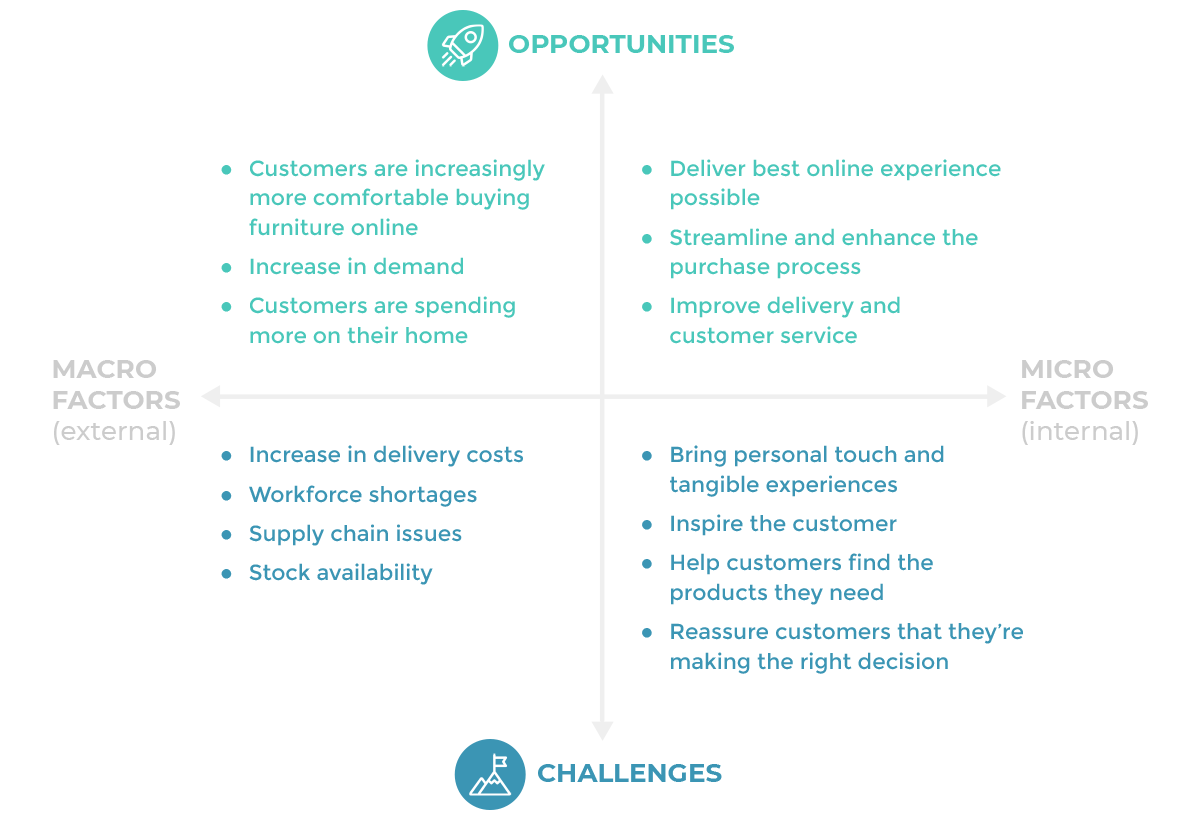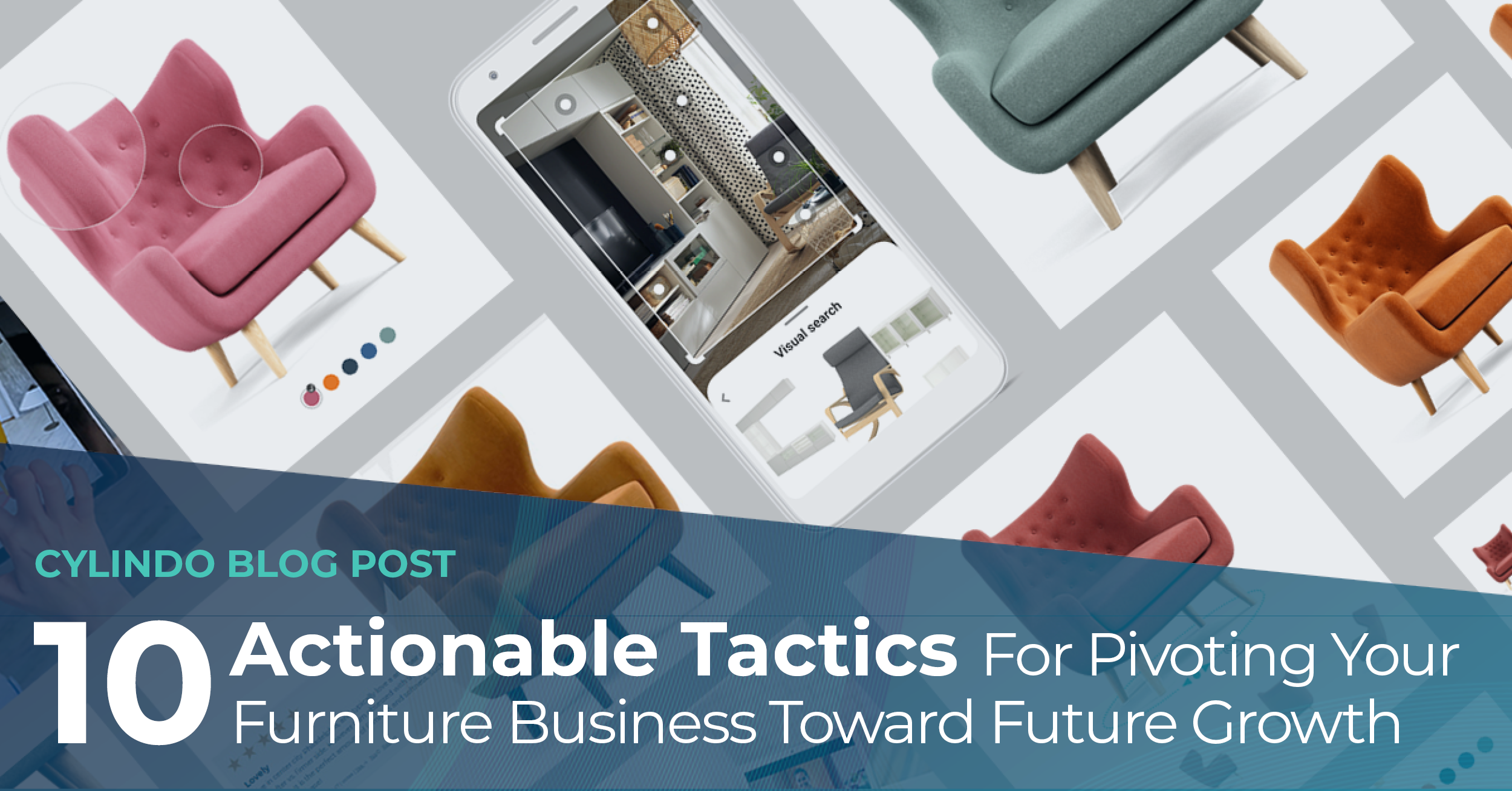Furniture retailers are emerging from the pandemic into a world where customer expectations are higher than ever. Despite the hardships over the last few years, more customers are shopping online than ever before. E-commerce is gaining steam, which opens up great opportunities for furniture businesses.
What will happen to furniture e-commerce? What new trends will define the industry? And most importantly, how can businesses prepare for — and take advantage of — rapidly evolving e-commerce trends?
We asked seven furniture industry-leading experts from all over the world to share their knowledge and main strategies for running a furniture business online in 2022.
Major challenges and opportunities in the current furniture industry landscape
Based on the replies we received from the experts, we’ve identified the major opportunities and challenges in the furniture industry, which we listed below.
In order to provide further context for the answers, we classified the opportunities and challenges according to whether they are internal (companies can influence them) or external (they depend on macro-environment factors such as supply chain issues, workforce shortages, etc.).

“There’s no doubt that the pandemic has shifted the mindset of both retailers and customers. We’ve learned that our customers are comfortable buying investment pieces online, and there is an incredible opportunity to streamline and enhance the purchasing process. The biggest challenge is bringing the personal touch and tangible experience of the showroom to the customer. At King, we choose to see this as an opportunity to innovate. It’s about utilizing our five decades of direct-to-consumer retail experience and marrying it with the best practices of e-commerce and digital.”
- Vanja Stace, Head of E-commerce at King

“The challenges in e-commerce remain the same as they’ve ever been, which are to inspire the customer, to help them find the right product for them, and to reassure them that they’re making the right decision. A key element in this is communicating the value of the products and the values of the brand. Brands that are able to tell a compelling story, whether it’s about heritage, design, quality, sustainability, low pricing, or whatever’s important to their target customers, will be the ones that succeed in the future.”
- David Kohn, E-commerce investor and advisor (former Customer and E-commerce Director at Heal’s)

“It’s imperative to provide optimum information and support to customers in what is a momentous and complex purchase that they’ll live with for years and defines their aesthetic. It requires design authority, evidence of quality, and comprehensive product information and visuals, all in the service of building confidence and interest, then delivering on the promise with flawless delivery and service.”
- Emily Xu, Chief Marketing Officer at Mitchell Gold + Bob Williams

“While the rise in fresh converts to online shopping will slow as the effects of the pandemic abate, the opportunity for growth remains huge. But, as much as standing out online and providing a journey that keeps the customer engaged from entry to checkout, the biggest challenge perhaps remains that of effective fulfillment. With rising delivery costs and widespread manpower shortages, the ability to execute a delivery when it’s promised could be the biggest make-or-break factor in whether a customer chooses to shop with an etailer again – and servicing repeat customers is far more profitable than starting from scratch.”
- Paul Farley, Editor-in-chief at Furniture News

“Our biggest challenges are currently related to logistics and supply chain issues. These challenges began at the beginning of the pandemic and have only gotten worse. Specifically, we're seeing lead times double and shipping costs increase as much as four times from two years ago. That said, furniture companies have an opportunity today to reach and engage with customers more easily now than ever domestically and across the globe. With more people working from home, we are seeing a sharp increase in demand year over year and consumers spending more on their homes now than when they were working in the office five days a week. Additionally, customers are increasingly more comfortable buying furniture online.”
- Donnie Criswell, Owner of Denver Modern

“We’ve seen a major shift in our customers’ attitudes to shopping online. People are far more comfortable shopping online for investment pieces such as sofas and dining tables. It’s an incredible opportunity for King as a furniture business. The challenge is ensuring we deliver the best online experience possible.”

“Unprecedented supply chain issues have been a recurring topic across all industries since the beginning of the pandemic, and the furniture industry is no exception. Product lead times and keeping bestselling lines in stock are ongoing challenges. However, these obstacles have presented opportunities for those businesses who reacted quickly and creatively to achieve a greater level of supply chain control. For example, Andrew Martin recently moved all its custom-made furniture ranges to a manufacturer in Wales, dramatically reducing production times for customers.”
- Helena Flynn, Head of Digital at Andrew Martin
Furniture e-commerce: What is its future, and how can businesses prepare for it?
COVID-19 put the brakes on autopilot and forced furniture businesses to re-examine the legacy systems and strategies that have shaped the industry for years. The good news: the pandemic has opened the door for a much-needed retail reset that will help furniture players reinvent their businesses and get ready for the future.
But here’s the tricky part: Furniture retailers are emerging from the pandemic into a world where customer expectations are higher than ever. Retailers must embrace technological advances if they wish to stay competitive.

“The future is channelless, and at the forefront is customer experience. A big part of this is acknowledging that the customer journey is not linear – it’s highly personal. We need to first understand, then enhance the experience across all touchpoints to ensure we’re facilitating informed decisions and building customer confidence.”
- Vanja Stace, Head of E-commerce at King

“E-commerce professionals are typically practical, logical people who focus on functionality and making it easier for users. The future of furniture e-commerce will increasingly be about making emotional connections and creating within users a real sense of the world they might inhabit if they buy into your brand. Businesses need to spend more time thinking about how they can inspire, excite, create aspiration, and bring pleasure to their users at every key touchpoint.”
- David Kohn, E-commerce investor and advisor (former Customer and E-commerce Director at Heal’s)

“Be relevant and useful to an increasingly design-interested customer who is concerned about the impact of their purchases. Utilize technology where it can make the consideration and purchase process more tangible and streamlined. We hear from customers over and over about challenges to visualize the scale of items so they can feel confident enough to buy.”
- Emily Xu, Chief Marketing Officer at Mitchell Gold + Bob Williams

“It’s an old refrain, but customer expectation is still growing, so e-commerce players need to be smarter, faster, and more creative — but they should also remember that people buy from people and ensure the relationships they have with partners, both upstream and down, are healthy. To this end, good communication is key. Social media (and the social commerce which springs from it) will play an increasingly important role, but businesses will need to walk the walk, not just talk the talk!”
- Paul Farley, Editor-in-chief at Furniture News

“Consumers, now more than ever, want to purchase from brands they love and connect with and don't exclusively consider price when making a purchase. E-commerce brands need to capture customers with a message that resonates with their customers and goes beyond price. Supporting social causes and green initiatives like donating to organizations that provide ways to offset carbon emissions caused by the production and shipping of goods is one example of how to attract and engage with a customer in today's online landscape. Supporting social causes and green initiatives today will help ensure that there is a future for furniture brands operating an e-commerce business.”
- Donnie Criswell, Owner of Denver Modern

“Personalization and understanding your customer are key. As we’ve said before, the future is channelless, and at the forefront is customer experience. We all need to remember that the customer journey is not linear, and it’s highly personal. The best way to prepare is to use the data to understand that journey and invest in the people who can value the customer experience.”

“The ultimate goal for furniture e-commerce businesses is to create a seamless end-to-end shopping experience that removes as many friction points in the customer journey as possible, whether that be online or in-store. Consumer behavior will continue to evolve and shape new shopping trends, so it's critical that businesses keep abreast with these changes and invest in new technologies and processes to future-proof their business.”
- Helena Flynn, Head of Digital at Andrew Martin
What’s next?
COVID-19 has irrevocably changed the furniture industry. Though navigating uncharted waters can be uncomfortable, doing so will pay off in the long run and help companies create sustained competitive advantage.
The bottom line is that furniture businesses should embrace the current disruption and commit to pivoting toward the future.
Curious to find out the main strategies or initiatives that furniture e-commerce businesses should focus on? Download the full e-book.





